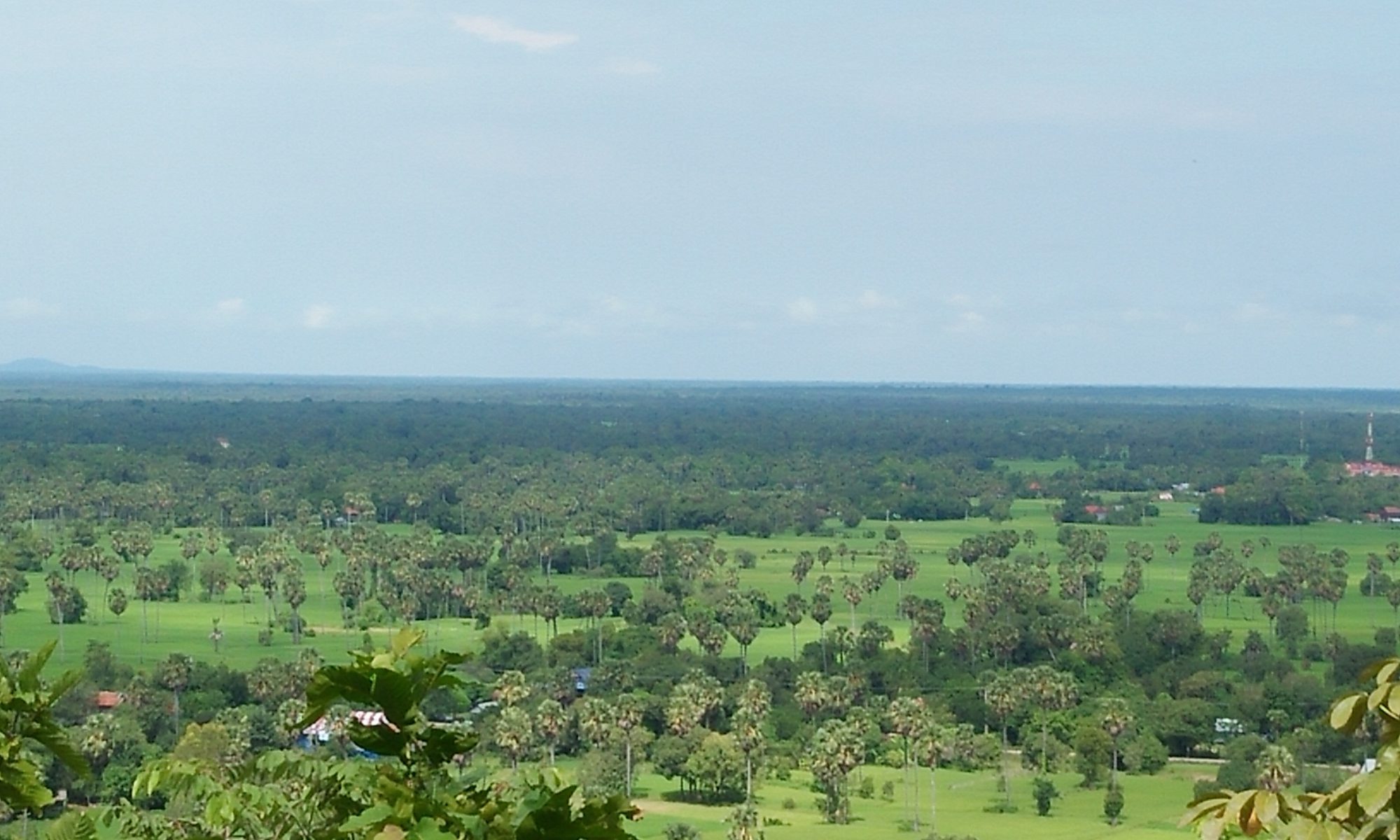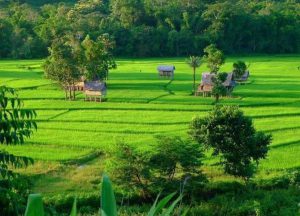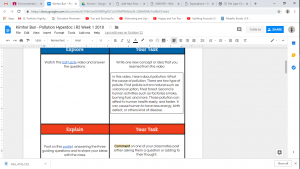Thailand is a developed country in southeast Asia. Thailand is bordering with Cambodia, Laos, Malaysia, and Myanmar. There are 68.86 millions people in 2016, which is 23.84 million people less than Vietnamese population. Thailand is 513,120 square kilometers. Its traditional language is Thai. Thailand has 76 provinces, 878 districts but not including 50 districts of Bangkok. The currency of Thailand is Baht. In Thailand, there are eight top sights to travel: Jim Thompson House, Wat Pho, Sukhothai Historical Park, Wat Phumin, Chatuchak Weekend Market, Wat Phra Kaew, Wat Phra That Lampang Luang, and Erawan National Park.
Jim Thompson is a jungly compound, which is the former home of the eponymous American silk entrepreneur and art collector. Born in Delaware in 1906, Thompson briefly served in the Office of Strategic Services in Thailand during WWII. He settled in Bangkok after the war. When his neighbours’ handmade silk caught his eye and piqued his business sense, he sent samples to fashion houses in Milan, London and Paris, gradually building a steady worldwide clientele.
Wat Pho is a rambling grounds of Wat Pho covering eight hectares, with the major tourist sites occupying the northern side of The Chetuphon and the monastic facilities found on the southern side. The temple compound is also the national headquarters for the teaching and preservation of traditional Thai medicine, including Thai massage, a mandate legislated by Rama III when the tradition was in danger of extinction. The famous massage school has two massage pavilions located within the temple area and addition rooms within the training facility outside the temple.
The architecture of Sukhothai temples is most typified by the classic lotus-bud chedi, featuring a conical spire topping a square-sided structure on a three-tiered base. Some sites exhibit other rich architectural forms introduced and modified during the period, such as bell-shaped Sinhalese and double-tiered Srivijaya chedi. Despite the popularity of the park, it’s quite expansive and solitary exploration is usually possible. Some of the most impressive ruins are outside the city walls, so a bicycle or motorcycle is essential to fully appreciate everything.
Wat Phumin is the most famous Buddhist temple, which is celebrated for its exquisite murals that were executed during the late 19th century by a Thai Lü artist named Thit Buaphan. The exterior of the temple takes the form of a cruciform bòht (ordination hall) that was constructed in 1596 and restored during the reign of Chao Anantavorapit Hide (1867–74). The ornate altar in the center of the bòht has four sides, with four Sukhothai-style sitting Buddhas facing in each direction.
Chatuchak Weekend Market is among the largest markets in the Thailand. Chatuchak seems to unite everything buyable, from used vintage sneakers to baby squirrels. Plan to spend a full day here, as there’s plenty to see, do and buy. But come early, ideally around 10 am, to beat the crowds and the heat.There are an information center and a bank with ATMs and foreign-exchange booths at the Chatuchak Park Office, near the northern end of the market’s Soi 1, Soi 2 and Soi 3. Schematic maps and toilets are located throughout the market.
Friday nights from around 8 pm to midnight, several vendors, largely those selling clothing, accessories, and food, open up shop in Chatuchak. There are a few vendors on weekday mornings and a daily vegetable, plant and flower market opposite the market’s southern side. One section of the latter, known as the Or Tor Kor Market, sells fantastically gargantuan fruit and seafood and has a decent food court as well.
Once you’re deep in the bowels of Chatuchak, it will seem like there is no order and no escape, but the market is arranged into relatively coherent sections. Use the clock tower as a handy landmark.
Antiques, Handicrafts & Souvenirs
Section 1 is the place to go for Buddha statues, old LPs, and other random antiques. More secular arts and crafts, such as musical instruments and hill-tribe items can be found in Sections 25 and 26. Baan Sin Thai sells a mixture of kŏhnmasks and old-school Thai toys, all of which make fun souvenirs, and Kitcharoen Dountri specializes in Thai musical instruments, including flutes, whistles, drums and CDs of classical Thai music. Other quirky gifts include the lifelike plastic Thai fruit and vegetables at Marché or their scaled-down miniature counterparts nearby at Papachu.
Clothing & Accessories
Clothing dominates most of Chatuchak, starting in Section 8 and continuing through the even-numbered sections to 24. Sections 5 and 6 deal in used clothing for every Thai youth subculture, from punks to cowboys, while Soi 7, where it transects Sections 12 and 14, is heavy on the more underground hip-hop and skate fashions. Somewhat more sophisticated independent labels can be found in Sections 2 and 3, while tourist-sized clothes and textiles are in Sections 8 and 10.
For accessories, several shops in Sections 24 and 26, such as Orange Karen Silver, specialize in chunky silver jewelry and semi-precious uncut stones.
Eating & Drinking
Lots of Thai-style eating and snacking will stave off Chatuchak rage (cranky behavior brought on by dehydration or hunger), and numerous food stalls set up shop between Sections 6 and 8. Long-standing standouts include Foontalop, an incredibly popular Isan restaurant; Café Ice, a Western-Thai fusion joint that does good, if overpriced, pàt tai (fried noodles) and tasty fruit shakes; Toh-Plue, which does all the Thai standards; and Saman Islam, a Thai-Muslim restaurant that serves a tasty chicken biryani. Viva 8 features a DJ and, when we stopped by, a chef making huge platters of paella. And as evening draws near, down a beer at Viva’s, a cafe-bar that features live music.
Housewares & Decor
The western edge of the market, particularly Sections 8 to 26, specializes in all manner of housewares, from cheap plastic buckets too expensive brass works . This area is a particularly good place to stock up on inexpensive Thai ceramics, ranging from celadon to the traditional rooster-themed bowls from Lampang.
PL Bronze has a huge variety of stainless-steel flatware, and Ton-Tan deals in coconut- and sugar-palm-derived plates, bowls and other utensils.
Those looking to spice up the house should stop by Spice Boom, where you can find dried herbs and spices for both consumption and decoration. Other notable olfactory indulgences include the handmade soaps, lotions, salts and scrubs at D-narn, and the fragrant perfumes and essential oils at AnyaDharu Scent Library.
For less utilitarian goods, Section 7 is a virtual open-air gallery – we particularly liked Pariwat A-nantachina for Bangkok-themed murals. Several shops in Section 10, including Tuptim Shop, sell new and antique Burmese lacquerware. Menu features a dusty mish-mash of quirky antiques from both Thailand and Myanmar.
Pets
Possibly the most fun you’ll ever have window-shopping will be petting puppies and be cuddling kittens in Sections 13 and 15. Soi 9 of the former features several shops that deal solely in clothing for pets. It’s also worth noting that this section has, in the past, been associated with the sale of illegal wildlife, although much of this trade has been driven underground.
Plants & Gardening
The interior perimeter of Sections 2 to 4 feature a huge variety of potted plants, flowers, herbs, fruits, and the accessories needed to maintain them. Many of these shops are also open on weekday afternoons.
Wat Phra Kaew: This pagoda was consecrated in 1782, the first year of Bangkok rule, and is today Bangkok’s biggest tourist attraction and a pilgrimage destination for devout Buddhists and nationalists. The 94.5-hectare grounds encompass more than 100 buildings that represent 200 years of royal history and architectural experimentation. Most of the architecture, royal or sacred, can be classified as Rattanakosin (old-Bangkok style).
Emerald Buddha
Upon entering Wat Phra Kaew you’ll meet the yaksha, brawny guardian giants from the Ramakien. Beyond them is a courtyard where the central bòht (ordination hall) houses the Emerald Buddha. The spectacular ornamentation inside and out does an excellent job of distracting first-time visitors from paying their respects to the image. Here’s why: the Emerald Buddha is only 66cm tall and sits so high above worshippers in the main temple building that the gilded shrine is more striking than the small figure it cradles. No one knows exactly where it comes from or who sculpted it, but it first appeared on record in 15th-century Chiang Rai in northern Thailand. Stylistically it seems to belong to Thai artistic periods of the 13th to 14th centuries.Because of its royal status, the Emerald Buddha is ceremoniously draped in monastic robes. There are now three royal robes: for the hot, rainy and cool seasons. The three robes are still solemnly changed by the king at the beginning of each season.
Ramakien Murals
Outside the main bòht is a stone statue of the Chinese goddess of mercy, Kuan Im, and nearby are two cow figures, representing the year of Rama I’s birth. In the 2km-long cloister that defines the perimeter of the complex are 178 murals depicting the Ramakian (the Thai version of the Indian Ramayana epic) in its entirety, beginning at the north gate and moving clockwise around the compound.The story begins with the hero, Rama (the greenfaced character), and his bride, Sita (the beautiful topless maiden). The young couple is banished to the forest, along with Rama’s brother. In this pastoral setting, the evil king Ravana (the character with many arms and faces) disguises himself as a hermit in order to kidnap Sita.Rama joins forces with Hanuman, the monkey king (logically depicted as the white monkey), to attack Ravana and rescue Sita. Although Rama has the pedigree, Hanuman is the unsung hero. He is loyal, fierce and clever. En route to the final fairy-tale ending, great battles and schemes of trickery ensue until Ravana is finally killed. After withstanding a loyalty test of fire, Sita and Rama are triumphantly reunited.If the temple grounds seem overrun by tourists, the mural area is usually mercifully quiet and shady.
Wat Phra That Lampang Luang is The ancient Buddhist temple compound houses several interesting religious structures, including what is arguably the most beautiful wooden Lanna temple in northern Thailand, the open-sided Wihan Luang. Dating back to 1476 and thought to be the oldest-standing wooden structure in the country, the impressive features a triple-tiered wooden roof supported by immense teak pillars and early 19th-century jataka murals (showing stories of the Buddha’s previous lives) painted on wooden panels around the inside upper perimeter.
A huge, gilded (the small square-sided building with a spire) in the back of the wí·hăhn contains a Buddha image cast in 1563.The small and simple Wihan Ton Kaew, to the north of the main was built in 1476, while the tall Lanna-style chedi (stupa) behind the main raised in 1449 and restored in 1496, is 45m high.Wihan Nam Team, to the north of the chedi, was built in the early 16th century and, amazingly, still contains traces of the original murals, making them among the oldest in the country.
South of the main chedi, Wihan Phra Phut dates back to the 13th century and is the oldest structure in the compound.Unfortunately, only men are allowed to see a camera obscura image of the chedi in the Haw Phra Phutthabat, a small white building behind the chedi. The image is projected (upside down) onto a white cloth and clearly depicts the colors of the structures outside.The lintel over the entrance to the compound features an impressive dragon relief, once common in northern Thai temples but rarely seen today. This gate allegedly dates to the 15th century.
In the arboretum outside the southern gate of the wát, there are now three museums. One displays mostly festival paraphernalia and some Buddha figures. Another, called House of the Emerald Buddha, contains a miscellany of coins, banknotes, Buddha figures, silver betel-nut cases, lacquerware and other ethnographic artifacts, along with three small heavily gold-leafed Buddhas placed on an altar behind an enormous repoussé silver bowl. The third, a small museum, features shelves of Buddha figures, lacquered boxes, manuscripts and ceramics, all well labeled in Thai and English.
Wat Phra That Lampang Luang is 18 km southwest of Lampang in Ko Kha. To get there by public transport from Lampang, flag a blue eastbound (passenger pick-up truck, 20B) on The Boonyawat. From the Ko Kha stop, it’s a 3 km chartered motorcycle taxi ride to the temple (60B). Alternatively, you can charter a from Lampang bus station for 400B, or taxis will take you there and back for around the same price.
If you’re driving or cycling from Lampang, head south on The Phaholyothin and take the Ko Kha exit, then follow the road over a bridge and bear right. Follow the signs and continue for 3km over another bridge until you see the temple on the left.
Erawan National Park is a Splashing in cerulean pools under Erawan Falls is the highlight of this 550 sq km park. Seven tiers of waterfall tumble through the forest, and bathing beneath these crystalline cascades is equally popular with locals and visitors. Reaching the first three tiers is easy; beyond here, walking shoes and some endurance are needed to complete the steep 2km hike (it’s worth it to avoid the crowds in the first two pools). There are hourly buses from Kanchanaburi.
Bring a swimming costume (and cover-up T-shirt) but be aware you’re sharing the bathing area with large, nibbling fish; monkeys have been known to snatch swimmers’ belongings. Level four has a natural rock slide and level six usually has the fewest swimmers. Buggies (adult/child 30/15B) can transport people with limited mobility to the first level. Picnickers, be aware that you can’t take food and drink to level three or beyond. Bottles of water are permitted but to prevent littering, visitors are asked to register bottles and leave a 20B deposit (which is returned when you show the bottle on your way back down).
Elsewhere in the park, Tham Phra That is a cave with a variety of shimmering limestone formations. Geologists find the caves of interest due to a clearly visible fault line. Contact the visitor center before driving the 12km out there and a guide will meet you with paraffin lamps. There are several other fantastic caves in the park, but they’re currently closed to the public.
The park was named for Erawan, the three-headed elephant of Hindu mythology, whom the top tier is thought to resemble. Mixed deciduous forest covers over 80 percent of the park, but there’s also dry evergreen and dry dipterocarp forest and big swathes of bamboo. Tigers, elephants, sambar deer, gibbons, red giant flying squirrels, king cobras and hornbills call the park home, but they don’t frequent the waterfall area and you’re unlikely to see them along the park’s limited trails.
From the visitor center, Mong Lay Dry Trail only takes an hour; for something more taxing, embark on the 5km Khao Hin Lan Pee Trail, a three-hour walk that takes you to the falls’ fifth tier.Park bungalows sleep between two to eight people. Tent hire is 150B to 300B; if you bring your own tent, there’s a 30B fee.From Kanchanaburi, buses (50B, 1½ hours) run hourly from 8 am to 5 pm and go right to the visitor center. The last bus back to town is at 4 pm, and on weekends it will be packed. Touts at the bus station will try to talk you into hiring a private driver instead of taking the bus, but this isn’t necessary.
All the 8 sights are the best places for visitors to have fun with family.
Purpose: The purpose of compiling this little booklet is for the visitors who want to visit Thailand and they are not sure where to visit.
School: Liger Leadership Academy
Teacher: Jan
Supported by: Bunthan
compiled by: Kimhor Bun
I would like to express my thanks to all of the teachers at Liger Leadership Academy who help and teaches me!
Reference


